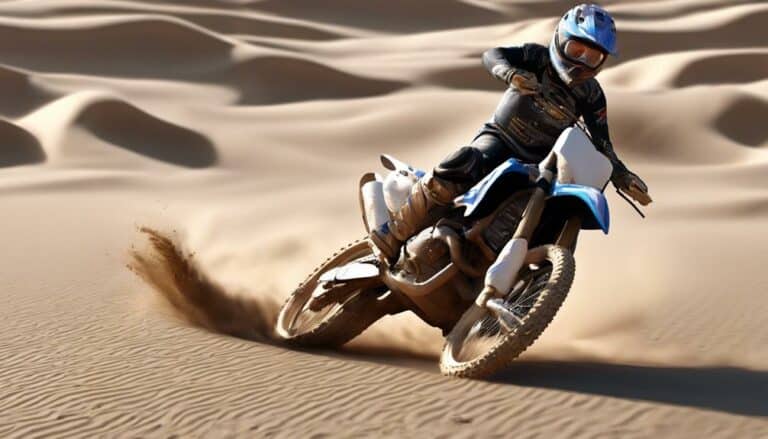When traversing soft sand versus hard-packed sand, riders must adapt their techniques to suit the terrain.
Did you know that nearly 80% of riders find moving through soft sand more challenging than hard-packed sand?
Understanding the differences in riding styles can make a significant difference in your performance and overall experience.
So, what specific adjustments do you need to make to conquer these varying terrains successfully?
Key Takeaways
- Weight distribution varies: lean back in soft sand, stay neutral in hard-packed sand.
- Throttle control differs: gradual in soft sand, aggressive in hard-packed sand.
- Brake usage changes: rear brake in soft sand, both brakes in hard-packed sand.
- Riding techniques adjust: stability-focused in soft sand, maneuverability-focused in hard-packed sand.
Soft Sand Riding Techniques
When riding on soft sand, lean back considerably and apply ample power to maintain momentum and prevent getting stuck. Soft sand presents a unique challenge due to its loose and shifting nature, requiring precise handling techniques.
To prevent the bike from digging in and losing traction, mastering throttle control is essential. By keeping your weight back and using steady gas, you can navigate through soft sand with greater ease.
When steering in soft sand, utilize the handlebars at higher speeds to maintain stability and control over the bike. It's vital to focus on being loose on the bars and using your feet to steer, allowing for better maneuverability in these challenging conditions.
Practice techniques such as slow turns and leaning back to avoid losing control and ensure a smoother ride. By incorporating these riding techniques, you can enhance your experience and feel more liberated when riding through soft sand terrains.
Hard-Packed Sand Riding Strategies
To navigate hard-packed sand terrains effectively, riders must maintain an upright position on the bike to guarantee top control and stability. When riding on hard-packed sand, the following strategies are essential for a successful and liberating experience:
- Tire Pressure: Adjust tire pressure to make sure the best traction and grip on the firm surface.
- Cornering in Sand: Utilize sharper turns and quicker maneuvers due to the stability of hard-packed sand.
- Front Brake Usage: Use the front brake judiciously to control speed and maintain balance on the solid ground.
- Lean Forward: Lean slightly forward to distribute weight evenly and enhance control over the bike's movements.
Experienced riders know that hard-packed sand demands a different approach than softer terrains. By mastering these strategies and understanding the dynamics of riding on hard-packed sand, you can confidently navigate sand dunes and enjoy the thrill of exploring new landscapes with precision and skill.
Weight Distribution Variances
Moving between soft and hard sand terrains requires adjusting weight distribution on your bike to optimize stability and traction, essential for effective handling and control. In soft sand, shifting more weight to the back of the bike helps prevent sinking and maintains traction, vital for traveling the challenging terrain. On the other hand, hard-packed sand demands a more neutral weight distribution, with less emphasis on the rear, to enhance stability and control, allowing you to maneuver with greater ease.
To demonstrate the impact of weight distribution variances on handling and traction in different sand conditions, consider the following table:
| Sand Type | Weight Distribution | Effect |
|---|---|---|
| Soft Sand | More weight on back | Prevents sinking |
| Hard-packed Sand | Neutral distribution | Enhanced stability |
Adjusting your weight distribution accordingly can significantly improve your ability to handle the bike and maintain traction, whether you are conquering soft sand dunes or cruising on hard-packed shores.
Throttle Control Adjustments
Adjusting your throttle control technique is pivotal in traversing the varying terrains of soft and hard sand, ensuring peak speed and traction. When riding on sand, throttle input plays a critical role in maintaining control over your bike. Here are some essential points to contemplate:
- Soft Sand: In soft sand, your throttle control should be smooth and gradual to prevent excessive wheel spin that can lead to sinking. Adjusting the throttle input in soft sand helps in keeping the bike stable and prevents loss of momentum.
- Hard-Packed Sand: In contrast to soft sand, hard-packed sand requires more aggressive throttle control to maintain speed and traction. Quick throttle responses are essential in maneuvering through the firmer terrain efficiently.
Mastering the discrepancies in throttle control between soft and hard-packed sand is vital for successful navigation and control. By understanding how throttle control influences wheel spin and traction, you can enhance your riding experience on both types of sand surfaces.
Braking Methods Comparison
When traversing soft and hard sand terrains, mastering the differences in braking methods is essential for maintaining control and safety.
In soft sand, where traction can be challenging, adjusting your braking techniques is important. To prevent front wheel washouts, rely more on the rear brake while reducing the use of the front brake. Soft sand demands gentle and gradual braking to avoid losing traction and control.
On the other hand, hard-packed sand offers better grip, allowing for more aggressive braking with both the front and rear brakes for quicker stops. In this firmer terrain, you can apply more assertive braking techniques confidently.
Adapting your braking approach based on the sand conditions you encounter is necessary for safe and effective riding. By understanding how to manipulate your front and rear brakes in different sand types, you can navigate diverse terrains with improved skill and security.
Conclusion
To sum up, mastering the differences in riding techniques between soft sand and hard-packed sand is important for traversing varying terrains with ease.
Remember the adage, 'Adapt or perish,' as you adjust your weight distribution, throttle control, and steering techniques to suit the terrain you encounter.
By understanding these differences and practicing proper techniques, you can confidently conquer any sand terrain you come across with precision and skill.

